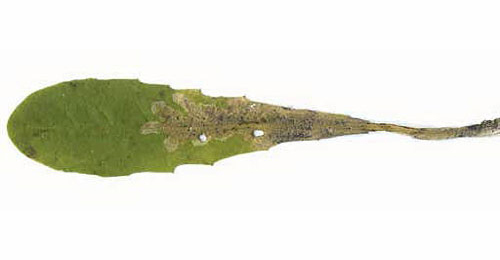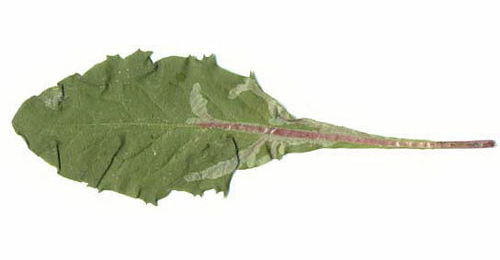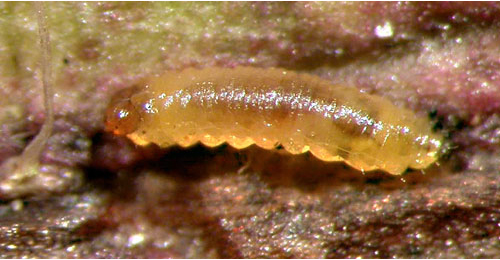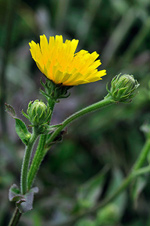|
||||||
|
PICRIS. Oxtongues. [Asteraceae] |
|
|
Two species of Picris are recorded in Britain. These include the native Hawkweed Oxtongue (P. hieracioides). Bristly Oxtongue (P. echioides) treated as Helminthotheca echioides by Stace (2010). Seven or eight British miners are recorded on Picris. The agromyzid Melanagromyza oligophaga forms galls in the upper part of the stem of Picris and other Asteraceae in Britain and elsewhere. A key to the European miners recorded on Picris is provided in Bladmineerders van Europa. |
|
Key for the identification of the known mines of British |
||
1a > Leaf-miner: Mine primarily associated with the mid-rib. |
||
1b > Leaf-miner: Mine not primarily associated with the mid-rib. |
||
2a > Leaf-miner: A distinctive mine primarily above mid-rib, with irregular short lateral offshoots into leaf blade. Pupation external (Spencer, 1972: 51 (fig. 172), 55; Spencer, 1976: 270, 271 (fig. 486)). Branched, whitish, upper-surface corridor; main axis overlying the midrib; side branches overlying the main lateral veins. (In Campanula and Phyteuma the mine is much less branched, sometimes nothing more than a corridor on top of the midrib). Frass in rather long strings. Usually the mines begins as a long and narrow, shallow, tortuous lower-surface corridor that ends upon the midrib but otherwise is not associated with the leaf venation. Often this initial corridor is filled with callus, and then even less conspicuous. Pupation outside the mine. A linear mine on the upper surface, usually following the midrib and showing side branches along the veins. The frass is in strings. |
||
|
||
|
||
Liriomyza strigata (Meigen, 1830) [Diptera: Agromyzidae]. |
||
2b > Leaf-miner: A whitish blotch mine along mid-rib, with offshoots into leaf blade. Pupation takes place at the base of the mid-rib (Spencer, 1972b: 25; Spencer. 1976: 63 (fig. 66)). The mine begins as a very narrow, upper- or lower-surface corridor, somewhere in the blade. When this hits a thick vein the larva uses this to descend towards the midrib. From that moment the lave lives in the hollow midrib. From here short, lobate corridors enter the leaf blade. The larva may move to another leaf by way of the leaf base. The corridors in the leaf are virtually free of frass (at most a few grains where they leave the midrib); frass is concentrated in the base of the midrib. Here also the pupation takes place. |
||
 Mine of Ophiomyia cunctata on Taraxacum officinale Image: © Willem Ellis (Bladmineerders van Europa) |
||
|
||
Ophiomyia cunctata (Hendel, 1920) [Diptera: Agromyzidae]. |
||
2c > Leaf-miner: A whitish blotch-mine along the mid-rib, with lateral offshoots into the leaf blade. Pupation at base of leaf in petiole (Spencer, 1972b: 25). Broad corridor overlying the midrib, with short excursion into the blade, mainly in its basal part. Frass concentrated in the basal part of the mine, corridors almost free from frass. Pupation in the mine, also in the basal part. |
||
 |
||
Mine
of Ophiomyia pulicaria on Taraxacum officinale |
||
|
||
Ophiomyia pulicaria (Meigen, 1830) [Diptera: Agromyzidae]. |
||
2d > Leaf-miner: The mine begins in the midrib, especially in a lower leaf, extending into the leaf disc, branching irregularly or pinnately, may also locally be blotch like. The mine is brown and very transparent. Sides very irregularly eaten out. Frass loosely dispersed or in a loose central line, buy may also be pressed against the sides of the corridor. The larva may also leave the mine and restart elsewhere. |
||
 Orthochaetes setiger larva, dorsal Image: © Jean-Yves Baugnée (Bladmineerders van Europa) |
||
|
||
Orthochaetes setiger (Beck, 1817) [Coleoptera: Curculionidae]. |
||
3a > Leaf-miner: Mine linear, whitish, both upper and lower surface. Pupation internal, at the end of the mine with the anterior spiracles projecting through the epidermis (Spencer, 1976: 433). Upper-surface, less often lower-surface corridor. Frass in isolated grains. Pupation within the mine, usually in a lower-surface puparial chamber. A long whitish upper surface corridor, which eventually goes lower surface. |
||
|
||
| Chromatomyia
horticola (Goureau, 1851) [Diptera: Agromyzidae] OR Chromatomyia syngenesiae Hardy, 1849 [Diptera: Agromyzidae]. |
||
3b > Leaf-miner: A lower and upper surface mine, unusually long, linear, conspicuously broad, frequently largely on the underside of the leaf. Pupation external. Puparium black |
||
|
||
Phytomyza marginella Fallén, 1823 [Diptera: Agromyzidae]. |
||
3c > Leaf-miner: A white mine along mid-rib, with offshoots into leaf blade. Pupation internal at base of mid-rib. In Asteraceae the larva mostly lives as a borer in the midrib of the leaves. From there short corridors are made into the blade. Also a corridor can be made overlying the midrib. In Euphorbia a small mine is made in the bracts of the inflorescence. The final mine strongly resembles the one of Liriomyza strigata, but the branches are vritually free from frass; this is acccumulated in the resting place of the larva, in the base of the midrib. There also pupation takes place. Forms a mine along the midrib and has feeding spurs into the leaf. Pupation is in the mine at the base of the midrib. |
||
|
||
Ophiomyia beckeri (Hendel, 1923) [Diptera: Agromyzidae]. |
||
| Last updated 09-Jul-2020 Brian Pitkin | ||


